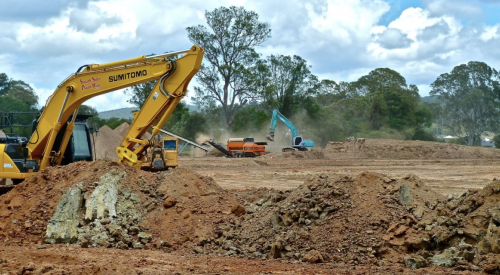| Sycamore Creek is a 715-acre, master-planned community in the Inland Empire of Southern California. The area is part of a conservation preserve spanning 71 acres that will protect the natural oaks, sycamores and creeks adjacent to Cleveland National Forest.
|
Partnering is not a science. It's an industry buzzword that means different things to different people. Some partnering programs are extremely elaborate and demand tons of paperwork and meetings. One partnering project used an auditorium for weekly meetings run by an ex-Army general who pounded his fist and yelled from the stage at anyone who busted deadline.
For most midsize home builders, such a program is too expensive and time-consuming. Subcontractors also complain about too many rules and too much time demanded of them. There's a balance, and it might be different for every builder or every project.
| As part of the partnering program practiced by Fieldstone Communities Inc., Sycamore Creek general manager Michael Vairin (second from right) holds weekly meetings on site with key trades to talk about who's doing what, where problems are and how they can work together to make things go more smoothly.
|
The Fieldstone Group of Companies started its trade partnering program in the mid-1980s, when very few home builders were doing it. We have refined it over the years to create a system that works well for us. At its best, partnering can save builders, subcontractors and consultants time and money. There’s no magic formula for a successful partnering program, but there is a solid concept and an essential attitude.
Beyond Trade Partners
The benefits of a trade partnering program - time savings, cost savings, better communication, understanding of a single goal and vision - can be expanded to other areas of the home building business, most notably community planning and startup.
Being a planner by nature and having spent 10 years as a city planner, I don't like surprises. I want to see where I'm going, understand how I'm going to get there and lay everything out at the start. For Sycamore Creek, a 715-acre master-planned community in California's Inland Empire, east of Los Angeles, we tested the parameters of our partnering program. We brought together a broad spectrum of key designers and consultants - the best team I could find - to take an image and a plan and translate it into a working, breathing project that ultimately will include 1,500 homes.
| Vairin and construction manager Brian Woods (second from left) get an update on project grading work. "Sometimes the best ideas come from the trade guys in the field," Vairin says. "They're the experts at what they do, and every day they experience the frustrations of somebody's doing something else that prevents them from doing their job. They know what needs to be done to fix it, but nobody brings them together to talk through it."
|
The Sycamore Creek project has a partnership team, a management team, a design team, an entitlement team, a construction team, a site team, a marketing team and a public relations team. Membership often overlaps, by design. We distribute schedules, notification of key events or changes and a master list of team contacts. It also includes the name and phone number of everyone from our attorneys to our air-quality consultant, from the local water district to major property owners nearby. My job is to encourage people to call and work with other team members individually as well. The idea is to create a single vision of what we're trying to achieve and keep everyone on track.
Builders often fall short of involving the broader team and miss opportunities to identify good ideas and avoid problems before they arise.
|
|
|
|
|
|
|
|
|
|
|
Involve Stakeholders
Sycamore Creek has a build-out of three to six years. We want to be perceived as a good neighbor during construction and long past completion. By partnering with community leadership early and demonstrating our responsiveness to meeting critical needs, we earned invaluable good will that we believe will last for years to come.
The Riverside County First District supervisor created a Municipal Advisory Council to achieve grassroots feedback on topics ranging from development to graffiti control. The MAC is composed of five or six local citizens actively involved in community affairs. In the spirit of partnering, we met early on with the MAC to discuss how Sycamore Creek could best meet community needs. As a result of
these meetings, we learned that Temescal Canyon, where Sycamore Creek is located, did not have proper fire department coverage.
While our plan calls for a permanent fire station, we did not realize the community's strong interest in an interim fire station. We followed up by meeting with the county fire chief and county staff and crafted a plan to build an interim fire station.
|
|
|
|
|
|
|
Listen to the Experts
Providing water and sewer to the Sycamore Creek community meant hiring dozens of subs for water and sewer infrastructure, from constructing a 4 million-gallon water tank and building water booster stations to laying miles of water and sewer lines. We discussed with our key trades the challenge of laying water and sewer lines under existing roads. They came up with a plan called "pot holing," which means identifying existing facilities in the roadway and developing a plan to work around them so as not to disrupt utility and other services to neighboring communities.
The next step was to develop a sequencing plan so that all trades could work together more effectively as a team. The initial strategy discussion worked so well that we are meeting with the key trades weekly to review the implications of their work on each other and develop the most efficient schedules. If each trade were left alone to decide priority and sequence, each most likely would gravitate to the easiest and less resistant areas first.
|
Sometime the best ideas come from the trade guys in the field. They're the experts at what they do, and every day they experience the frustrations of somebody's doing something else that prevents them from doing their job. In the industry, we call this a "schedule delay" that results in "cost overruns." The folks in the field usually know what needs to be done to fix it, but nobody brings them together to talk through it.
Too many builders fail to ask what they can do to make the system more efficient. At Sycamore Creek, where we're busy breaking ground, we hold a weekly meeting with the construction trades, land development consultants, grading operations and underground contractors. The key guys talk about where they are, where they need to be and what's standing in the way. It makes their jobs easier, cuts down on frustration and saves everyone time and money.
All this might sound like common sense. But you would be surprised how seldom it works out like this. Generally, everyone just focuses on "The Schedule." They work so quickly - get it done today, get out there, get to work. Everyone pushes so fast and so hard that they don't have time to think - much less talk - about the big picture.
My attitude is that you can bring down a tree with a dull saw or take a little time to sharpen it and get it done faster. Partnering means taking the time to sharpen your saw.
Once you institute a partnering system and use it regularly, you can attract quality subs because it's easier to schedule and make money on your projects. In return, they'll help you hit budgets and meet deadlines, so your projects will get built faster and with higher quality.
It might take new systems and strategies to organize your business for successful partnering. Above all, it takes commitment. Partnering flows out of that commitment - not to just the concept, but also the tools that make it work. You must invest time, effort and careful thought on the front end, but partnering will pay it all back in the end.
Michael Vairin, a 15-year veteran of Fieldstone Communities who most recently served as its vice president of operations, is general manager of Sycamore Creek, a new master-planned community just south of Corona, Calif., in one of the 10 fastest-growing housing markets in the nation.












